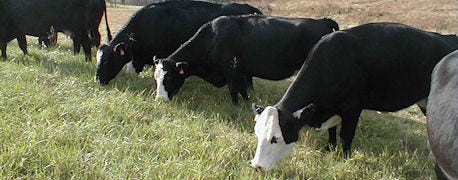May 30, 2013

Grazing sheep with cattle is an old idea, but it may a good new way for beginning farmers and ranchers to get started, says David Ollila, South Dakota State University extension sheep specialist.
You don't need more land – you just mix the sheep in with the cattle. The sheep don't reduce the available forage for the cattle because they graze different plants than the cows. The pasture even improves. Everyone wins.
At least that's the idea. But aren't any hard numbers to back up the idea yet. SDSU researchers hope to get them. They have launched a multi-species grazing project to study the impact on range health and livestock production.

New Twist On Old Practice For Beginning Farmers, Ranchers
"The idea of grazing sheep and cattle together -- at a one-to-one stocking rate -- isn't a new concept," says Ken Olson, SDSU extension beef specialist. "It's an age-old piece of rancher wisdom that has floated around for a long time. In fact, I can find references to it in Range Management texts from the 1930s."
The research that has been done has looked at range health when 50% of a cattle herd is replaced with its animal unit equivalent of sheep and both species graze together. For example, if the stocking rate for a particular pasture is 100 cows, then 50 cows would be removed and replaced with 250 sheep because five sheep is the animal unit equivalent to one cow. SDSU researchers will be looking adding one ewe for every cow.
Imitating nature
Historical evidence tells us that for as long as South Dakota's grasslands have existed, multitudes of species grazed them concurrently. Species diversity on rangeland enhances plant diversity and overall range health says, Roger Gates, SDSU Extension rangeland management specialist.
"Characteristics of healthy rangeland are a great diversity of plants and, in a natural system, a great diversity of herbivores," Gates says.
Because cattle and sheep prefer different plant species -- cattle tend to graze more grasses while sheep tend to graze more forbs and shrubs -- running them together should improve range quality and quantity.
~~~PAGE_BREAK_HERE~~~
"This evens out the pressure across a diversity of plants presented," Gates says. "It's generally beneficial to range health that we, to the extent that we can in agricultural operations, emulate and imitate natural systems."
Ranchers Dan and Sharon Anderson, Glad Valley, S.D., agree with Gates. For at least two generations, the Anderson family has grazed sheep and cattle together on most of the more than 11,000 acres of rangeland they manage. Dan says that not only does this allow him to bring in profits from two livestock enterprises, but grazing sheep also keeps noxious weeds and sage brush under control.
"We always figured we could very easily run one sheep per cow and never impact the amount of grass available, because the overlap of species they eat is so minimal," Dan Anderson said.
Land stewardship plays an important role in Anderson's grassland management. Over the years they have installed more than 15 miles of cross fencing and 10 miles of pipeline to allow for and enhance rotational grazing. Although the cattle and sheep graze the same pastures, they don't run the animals side by side. Instead, they follow the cattle rotation through a pasture with their 500-ewe sheep flock.
All the Andersons' pastures are fenced for both sheep and cattle and they have concrete steps in their watering tanks to provide an escape route in case a sheep falls into one of the 2-foot deep tanks.
Dan says there are several reasons that don't run the two species through a pasture at the same time. The main one is that the Andersons use dogs and donkeys for predator control in their sheep flock, If the sheep and cattle are in the same location at the same time, the dogs have a tendency to herd the cattle away from the sheep and the donkeys pay more attention to the cattle than sheep.
Helping the Next Generation Get a Start
Ollila says one reason cattle producers may not currently run sheep on their ranch is simply the fact that although sheep are relatively inexpensive to raise, they require more labor than cattle. If that's the case, an established rancher might be able to help a beginning farmer or rancher get started with a sheep enterprise by leasing him grazing rights.
"A big challenge for many beginning sheep producers is land availability," Ollila says. "There are many cattle operations who could take in a sheep enterprise by leasing land to a beginning producer. This may provide an opportunity for current ranchers to generate additional revenue by developing a multi-species grazing relationship."
The SDSU research team is currently looking for cattle producers who would be interested in cooperating in this research project. To learn more or to volunteer to participate in this project, contact Ollila at the SDSU Extension Regional Center in Rapid City, 605-394-2236 or [email protected].
Source: SDSU
You May Also Like




